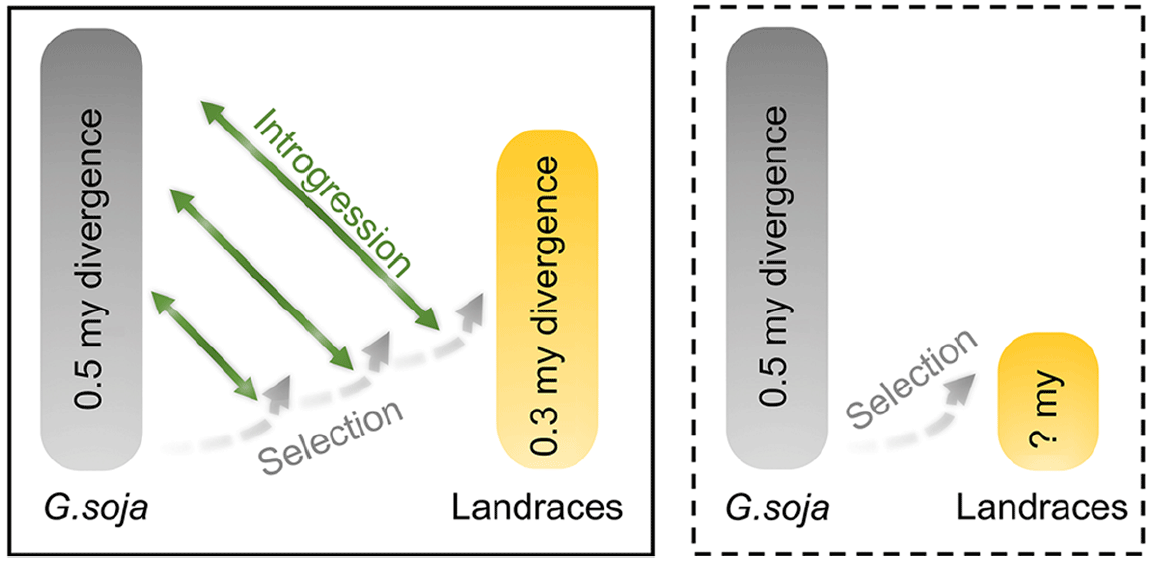博文
Genome Biology:大豆野生种与驯化种之间基因滲入的演化模式
||
Genomic introgression through interspecific hybridization counteracts genetic bottleneck during soybean domestication
First author: Xutong Wang; Affiliations: Purdue University (普渡大学): West Lafayette, USA
Corresponding author: Jianxin Ma
Evidence of introgression, the transfer of genetic material, between crops and their wild relatives through spontaneous hybridization and subsequent backcrossing has been documented; however, the evolutionary patterns and consequences of introgression and its influence on the processes of crop domestication and varietal diversification are poorly understood. We investigate the genomic landscape and evolution of putative crop-wild-relative introgression by analyzing the nuclear and chloroplast genomes from a panel of wild (Glycine soja) and domesticated (Glycine max) soybeans. Our data suggest that naturally occurring introgression between wild and domesticated soybeans was widespread and that introgressed variation in both wild and domesticated soybeans was selected against throughout the genomes and preferentially removed from the genomic regions underlying selective sweeps and domestication quantitative trait locus (QTL). In both taxa, putative introgression was preferentially retained in recombination-repressed pericentromeric regions that exhibit lower gene densities, reflecting potential roles of recombination in purging introgression. Despite extensive removal of introgressed variation by recurrent selection for domestication-related QTL and associated genomic regions, spontaneous interspecific hybridization during soybean domestication appear to have contributed to a rapid varietal diversification with high levels of genetic diversity and asymmetric evolution between the nuclear and chloroplast genomes. This work reveals the evolutionary forces, patterns, and consequences of putative genomic introgression between crops and their wild relatives, and the effects of introgression on the processes of crop domestication and varietal diversification. We envision that interspecific introgression serves as an important mechanism for counteracting the reduction of genetic diversity in domesticated crops, particularly the ones under single domestication.
已有证据表明作物和近缘野生种之间通过自发的杂交以及随后的回交存在遗传物质交换的现象,也叫基因滲入。但目前关于基因滲入的演化模式和结果以及其对于作物驯化和品种多样化的影响还研究得较少。作者通过分析一组野生大豆Glycine soja和驯化大豆Glycine max的核和叶绿体基因组来研究作物-野生种之间基因滲入的演化模式。本文的研究结果显示野生种和驯化大豆之间自然发生的基因滲入广泛分布,并且野生种和驯化大豆中基因滲入变异在全基因组范围上都受到了选择,且在基因组上的选择性清除位点和驯化数量性状位点中优先被移除。在野生种和驯化大豆中,基因滲入在重组受到抑制且基因密度较小的近着丝粒区优先保留,说明重组可能会作用于基因滲入的消除。除了驯化相关QTL及相关基因组区域的轮回选择消除基因滲入变异外,大豆驯化过程中自发的种间杂交可能作用于品种的迅速多样化以及核基因组与叶绿体基因组之间的不对称演化。本文的工作揭示了作物野生种和驯化种之间基因滲入的演化动力、模式和结果,以及基因滲入对于作物驯化和品种多样化的影响。作者预想种间的基因滲入可以作为一种重要的机制以抑制驯化作物多样性的降低,尤其是那些单一驯化的作物。
通讯:Jianxin Ma (https://ag.purdue.edu/agry/directory/Pages/maj.aspx)
个人简介:1996-1999年,中科院,博士。
研究方向:开花植物的结构和功能基因组学,关注复制驱动和转座子介导的基因和基因组演化;大豆株型、产量、疾病抗性等重要农艺性状和大豆驯化性状的遗传基础;利用大豆野生资源进行育种。
doi: https://doi.org/10.1186/s13059-019-1631-5
Journal: Genome Biology
Published date: January 30, 2019
https://blog.sciencenet.cn/blog-3158122-1163187.html
上一篇:The EMBO Journal:细胞板相关蛋白PI4Kβ在植物胞质分裂过程中的作用
下一篇:Nature Plants:SOSEKI蛋白影响拟南芥植株整体极性
全部作者的其他最新博文
- • Plant Physiology:CsMADS3促进柑果中的叶绿素降解和类胡萝卜素合成(华中农业大学)
- • Molecular Plant:LBD11-ROS反馈调节作用于拟南芥的维管形成层增殖和次生生长(浦项科技大学)
- • Science Advances:根结线虫通过调控植物的CLE3-CLV1模块,促进侵染进程(日本熊本大学)
- • Nature Communications:油菜素内酯参与植物营养生长期转变的分子机制解析(浙江农林大学)
- • Current Biology:光合作用产生的蔗糖驱动侧根“生物钟”(德国弗莱堡大学)
- • PNAS:花同源异型基因在叶中被抑制、花中被激活的分子机制(南卡罗来纳大学)

